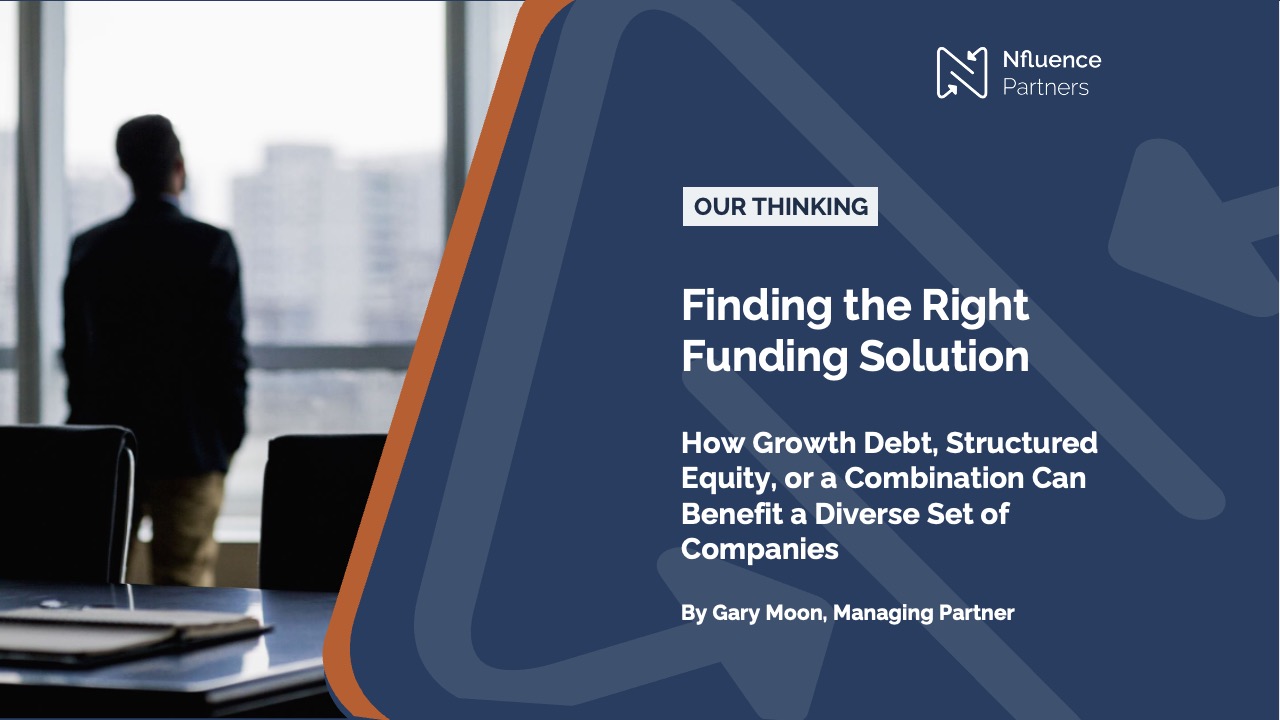Finding the Right Funding Solution
How Growth Debt, Structured Equity, or a Combination Can Benefit a Diverse Set of Companies
By: Gary Moon, Managing Partner, Nfluence Partners
gary@nfluencepartners.com

Key Takeaways
- When growth equity is either unavailable or undesirable, growth debt and structured equity offer additional funding options to growing companies.
- For companies that are finding access to growth equity challenging, growth debt provides a way to continue to invest in growth.
- Structured equity may be an attractive solution for a variety of reasons, including achieving a more favorable valuation or avoiding a down round.
- For some companies, the ideal financing package may be a combination of growth debt and structured equity.
It is a tough time for many private companies looking to raise capital. The precipitous drop in equity-market valuations, the collapse of key lenders like Silicon Valley Bank, and the retrenchment of VC firms has made growth equity harder to raise. In addition, venture debt typically is only available as part of an equity round. With both growth equity and flexible senior lending now in short supply, many companies are facing stark choices, including raising capital at an undesirable valuation, accepting a down round, or cutting their burn and reining in their growth ambitions.
Fortunately, there are options beyond growth equity and senior debt. Structured equity or growth debt, or a combination of the two, provides firms with a way to secure the financing they need to grow their businesses throughout the economic cycle. We distinguish growth debt, where a lender underwrites the fundamentals of the business in contrast to venture debt where a lender underwrites the relationship with the company’s investors. Companies can secure growth debt independent of a traditional funding round, and, contrary to popular belief, growth debt is not just for EBITDA-positive companies. Meanwhile, structured equity can be an attractive option for many companies, including those that are unable to secure acceptable valuations with a traditional growth equity round.
Whether growth debt, structured equity, or a combination of debt and equity is right for a company depends on several factors, including the company’s profitability, growth trajectory, and revenue, as well as intangibles such as board or founder preference. We examine three approaches that highlight solutions for companies at different stages of their development.
Using Debt as a Bridge to Growth (and Profitability)
Many startups are stuck between a rock and a hard place when it comes to growth equity. They may have achieved $10 million in annual recurring revenue (ARR), with reasonably high 25% top-line growth, but they are still not big enough or growing fast enough to attract traditional growth equity, particularly in the current tight funding environment. We see lots of successful companies facing this scenario in today’s market.
Without an infusion of capital, companies in this position may be forced to make difficult choices between growth, profitability or even survival. They abandon promising growth initiatives that may lead to profitability in the medium term, but cost significant dollars in the short term, choosing to survive solely off of their existing cashflows.
This is where growth debt can help. By providing companies that have a solid revenue stream, a proven business model, and a realistic path to profitability, with a non-dilutive source of capital, growth debt offers founders an attractive path to reach the milestones required to attract growth equity, and to achieve profitability.
As with all investments, finding a structure that both meets the needs of the company and provides a competitive return and adequate protections for the investors is critical. Growth debt funding structures can vary widely, but some things we might expect to see include a base rate that floats off an index like LIBOR, an interest-only option for a portion of the loan’s life, partial amortization and warrants.
Avoiding an Unfavorable Valuation (or a Down Round) with Structured Equity
While growth debt can be an attractive solution for companies that are not big enough to garner growth equity, some companies that are big enough face a different problem: securing equity at an acceptable valuation. As markets have repriced over the past year-plus, many founders are looking at what appear to be three relatively unappealing options: accepting a valuation significantly below what the board and their investors believe is justified, agreeing to a down round of growth equity, or going all-in on trying to figure out a way to maintain their prior valuation in a very different market environment.
Structured equity financing offers a potential solution to these unattractive alternatives. Structured equity financing may include preferred equity (with either a cash or a PIK dividend), a liquidation preference, a conversion feature, and possibly a board seat benefitting both founders and investors.
Because investors gain valuable concessions in the form of dividends and liquidation preferences, they are more comfortable underwriting the deal at a higher valuation than they would with a traditional growth equity investment. This alternative enables founders to secure a more attractive valuation, including avoiding a down round.
Finetuning a Solution with Both Debt and Equity
Although growth debt and structured equity each offer standalone solutions for certain companies, others also benefit from a financing package that includes both debt and equity.
For example, consider a small, early-stage company with $5 million in ARR that is growing rapidly (≈60%)and earning impressive gross margins (≈80%), but is burning cash at a fairly rapid pace. The firm would be too small and too early in its development to qualify for traditional growth capital but is in need of a capital infusion to drive tangible growth opportunities.
In this case, a hybrid debt/equity package could be the most appropriate solution. The debt portion would include an attractive coupon (and possibly some warrants) to adequately compensate the investors for the risk, as well as an interest-only provision for a period of time to provide the company with a runaway to achieve its next set of growth targets.
Pairing the debt with an equity co-investment brings benefits to both the investors and the founders. By layering debt on top of equity, investors are more willing to increase the valuation, as they have the added security of sitting at the top of the capital stack on the debt portion of the deal. Founders achieve a higher valuation than under a pure equity solution (if one were even possible) while taking on a lower debt burden than under a pure debt solution.
These are just a few examples of the ways that growth debt and structured equity can benefit a diverse set of companies at different points in their evolution, while delivering attractive outcomes to investors in an increasingly competitive space. Whether you are a founder looking for the optimal capital solution for your firm or an investor seeking to add to your portfolio of growth companies, please reach out to us at Nfluence to learn more about current market conditions and how we can help you navigate them.















